| Author |
Message |
|
Paul B.G
|
 Posted: Sat 11 Feb, 2012 8:36 pm Post subject: Posted: Sat 11 Feb, 2012 8:36 pm Post subject: |
 |
|
Beautiful work Peter, Its complex swords like this that really show that smiths of old (& yourself) were more than weapon makers but also artists.
Any chance that this sword with enter the Albion Museum Line-up? 
Cheers - Paul
A successful marriage requires falling in love many times, always with the same person
O====[::::::::::::::::::::::::::::>
Tho’ much is taken, much abides; and tho’
We are not now that strength which in old days
Moved earth and heaven; that which we are, we are;
One equal temper of heroic hearts,
Made weak by time and fate, but strong in will
To strive, to seek, to find, and not to yield.
—Alfred Lord Tennyson, Ulysses
|
|
  |
 |
|
Tim Lison
|
 Posted: Sat 11 Feb, 2012 9:12 pm Post subject: Posted: Sat 11 Feb, 2012 9:12 pm Post subject: |
 |
|
|
Magnificent work Peter! Swords like this are what we sword lovers dream about! So sleek and graceful...breath taking in it's beauty!
|
|
  |
 |
Jean Thibodeau

|
 Posted: Sat 11 Feb, 2012 10:33 pm Post subject: Posted: Sat 11 Feb, 2012 10:33 pm Post subject: |
 |
|
Peter, very nice work as usual.
One question about the pommel type: I notice that the pommel on the Albion Doge is of a similar type, any comments about the prevalence of these types of pommels and if they where used on a variety of sword types but seemed very popular with the Venetian swords of the Doge type ?
You can easily give up your freedom. You have to fight hard to get it back!
|
|
  |
 |
Jean Thibodeau

|
 Posted: Sat 11 Feb, 2012 10:45 pm Post subject: Posted: Sat 11 Feb, 2012 10:45 pm Post subject: |
 |
|
| Peter Johnsson wrote: | | The sword from last year´s Park Lane fair: a replica of one of the type XVIII of the Castillion find. |
Just a little Typology nit picking: I have a very similar sword made by Michael Pikula that I think you had a chance to look at a recent sword maker seminar late last Summer, and it and you sword as well as the original sword of the Castillion find seems closer to a type XV to me in blade profile ?
To me a Type XVIII would have a little bit more curve or belly in the blade at least near the last third of the blade ?
Functionally I don't think it makes much difference if it's called a XV or an XVIII as it would take very little changes in it's profile to make it either a certain type XV or a certain type XVIII: Actually, a period original sword might end up crossing type designations just dues to a few sharpening ?
Well. an impressive and attractive sword whatever one chooses to call it.
You can easily give up your freedom. You have to fight hard to get it back!
|
|
  |
 |
|
Peter Johnsson
Industry Professional
|
 Posted: Sun 12 Feb, 2012 1:03 am Post subject: Posted: Sun 12 Feb, 2012 1:03 am Post subject: |
 |
|
Thanks Paul, Tim and Jean.
-Paul: The making of a sword naturally involves skills of different kinds. There is the obvious knowledge of the tools of the trade and how to best treat materials involved. Forging, grinding, heat treat and possibly decorative techniques of inlay, engraving, gilding and work with silver and gold.
These tasks were normally divided between different craftsmen and experts back in the day. The making of a sword was a group effort.
Then there is an element of engineering. The sword is not simply a an object of iron and steel that passively has to withstand certain loads and impacts. It has to have a balance that is adjusted for its intended use. It also has to effectively deal damage to different types of targets.
The knowledge of how these aspects are best combined in a sword can perhaps be governed by traditions of the craft. A kind of "silent knowledge"- But I do not think this can fully explain the experience and knowledge of blade smiths and sword makers was about. I think they had concepts of what they were doing, some manner to describe and define functional properties of swords.
Then there is also the aesthetic quality of swords. They were made with an eye not only to function, but also to beauty. To the modern mind beauty is something that can be discussed apart from the engineering of an object. To the medieval mind, beauty involved more than what was pleasing to the eye. Beauty was a reflection of the divine order of things.
Looking at the proportions of medieval swords we can see that the makers were interested in proportions. They can be based on whole number fractions but also on irrational numbers like root 2, root three or Phi / golden section.
Most any one today who has had some artistic training will be introduced to the importance of these ratios in art and design. They are fundamental tools for artist and designer even today.
I think there was an element of design to the making of swords in medieval times. A deliberate planning of the form and proportions of the weapon. I think the functional and aesthetic aspects that we can observe in medieval swords did not come about haphazardly. I think much may have been the result of direct decisions that made sense in more than one way.
-Tim: the sword of dream. That is something to strive for :-)
-Jean: Yes the pommel is of the same basic type as those famous Venetian ones. If it is a type that is exclusively Venetian, I don´t know. Perhaps. Robert Woosnam-Savage of the Royal Armouries in Leeds thinks that these swords from the Castillion group are Italian.
I know of some swords of Burgundian context that have this type of pommel. They may also be of italian origin of course, or it might be an Italian/burgundian type. I am indebted to our Fabrice Cognot who pointed out those burgundian swords to me.
I agree with you that the difference between some type XV and XVIII is very slight. An aspect may be how wide the blade is before the point. With a broader base of the blade, it takes less of a curvature of the edge to have an effective width for cutting, while a blade with a narrower base can have more curvature in the edges and still be sword dedicated to thrusting.
|
|
   |
 |
|
Peter Johnsson
Industry Professional
|
 Posted: Tue 14 Feb, 2012 12:57 am Post subject: Posted: Tue 14 Feb, 2012 12:57 am Post subject: |
 |
|
Some little progress has been made.
Since last post the guard has now arrived at its final form with work on surface finish yet to be done.
Rivet shank and pommel has been prepared for peening.
Some more light grinding has been done on the blade to refine cross section, point and ricasso.
The sword is now some 15 grams lighter and starts to come alive in the hand.
-Thanks for looking!
 Attachment: 39.45 KB Attachment: 39.45 KB
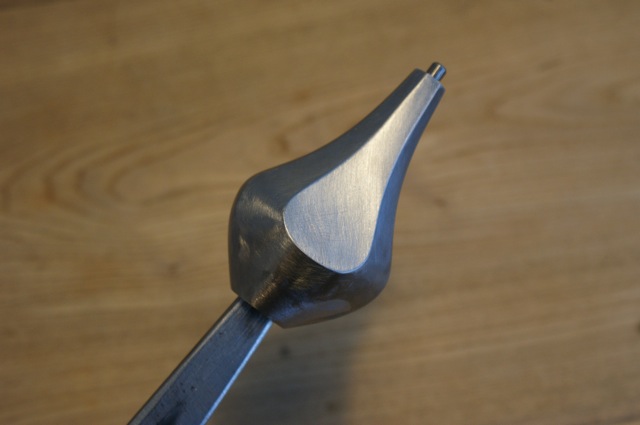
 Attachment: 28.64 KB Attachment: 28.64 KB
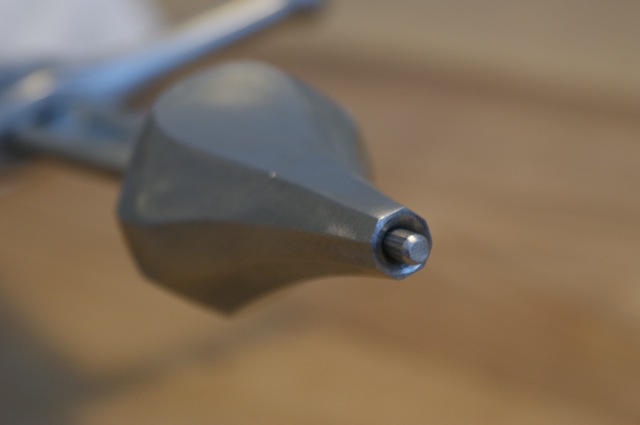
 Attachment: 47.72 KB Attachment: 47.72 KB
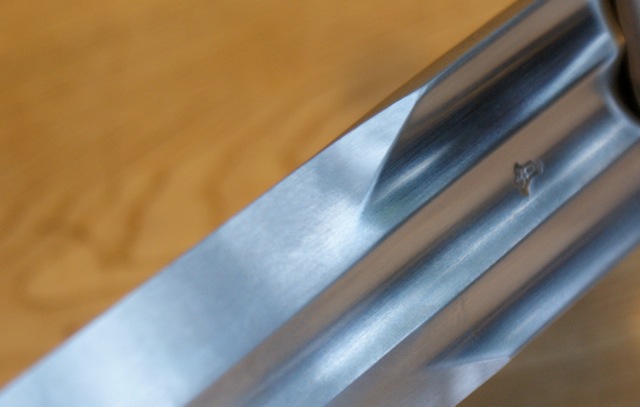
 Attachment: 57.61 KB Attachment: 57.61 KB
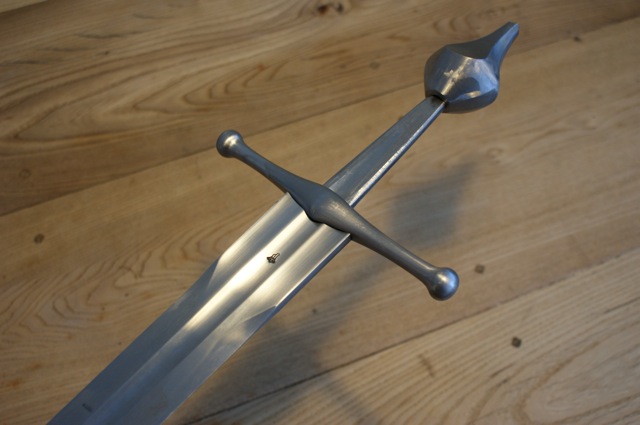
Last edited by Peter Johnsson on Tue 14 Feb, 2012 1:03 am; edited 1 time in total
|
|
   |
 |
Nathan Robinson
myArmoury Admin


|
|
    |
 |
|
Charles Richmond
|
 Posted: Tue 14 Feb, 2012 6:55 am Post subject: Posted: Tue 14 Feb, 2012 6:55 am Post subject: |
 |
|
The work on the ricasso of your blade is absolutely magnificent Peter.
Subtly complex and drop dead gorgeous are terms applied to your work more often than not, but this one really tops the charts.
|
|
  |
 |
Matt Easton

|
 Posted: Tue 14 Feb, 2012 9:11 am Post subject: Posted: Tue 14 Feb, 2012 9:11 am Post subject: |
 |
|
Hi Peter,
Great work as always! I hope to be able to see this and yourself at the arms fair.
I'm very much looking forward to the article as well - for those of you who can not attend the arms fair in person it might be useful for you to know that you can buy the event catalogues (including back issues with articles by people like Ewart Oakeshott) from the event organisers or through a couple of military history book dealers based in the UK (I'm not sure if I'm allowed to advertise their names here!). If you google 'park lane arms fair catalogue' then you'll probably find them.
Regards,
Matt
Schola Gladiatoria - www.swordfightinglondon.com
YouTube: www.youtube.com/user/scholagladiatoria
Antique Swords: www.antique-swords.co.uk/
|
|
    |
 |
|
Peter Johnsson
Industry Professional
|
 Posted: Tue 14 Feb, 2012 12:18 pm Post subject: Posted: Tue 14 Feb, 2012 12:18 pm Post subject: |
 |
|
Thank you!
-Nathan: I am here for you ;-)
-Charles: Thank you!
-Matt: I hope we meet in London in March. It would be great to see you there.
|
|
   |
 |
|
Keith L. Rogers
|
 Posted: Thu 16 Feb, 2012 2:15 pm Post subject: Posted: Thu 16 Feb, 2012 2:15 pm Post subject: |
 |
|
| Peter Johnsson wrote: | .... The sword is now some 15 grams lighter and starts to come alive in the hand.
|
If 15 grams makes a noticeable difference, it must be a very finely tuned sword indeed. The strong closeup photo of the ricasso to blade area leaves me speechless. The many intersecting lines and complex curves are absolutely exquisite. Beautiful, just beautiful beyond words. Outstanding work, Peter.[/img]
|
|
  |
 |
|
Peter Johnsson
Industry Professional
|
 Posted: Thu 23 Feb, 2012 1:51 pm Post subject: Posted: Thu 23 Feb, 2012 1:51 pm Post subject: |
 |
|
Some progress has been made since last. The sword is now riveted together and I shall next start work on fitting the grip.
A few days have been spent working on a scabbard, but the wood core has been putting up a good fight, resisting my attempts to finish in time for the fair. We shall see if it will be completed or not. Scabbards can be more of a challenge than the sword itself, I often find.
Early on in the thread I gave the weight of the original to around 1100 grams. This was wrong. It is only 1010 grams in present state of preservation, although it may have been close to 1100 grams when it was new.
I have been working some more on the blade, making the cross section leaner and thereby gaining a few more grams. The pommel has also been hollowed out a bit, reducing the weight further. The reconstruction now weighs 1075 grams without grip and has a point of balance some 14 millimeters farther away from the hilt, than the original presently has.
Given the sword has lost material in the blade from a number of deep gouges and holes through the blade, while the hilt survives pretty much intact, I think the reconstruction is a decent estimate of the original mass and balance of the sword.
As it is now, the sword has good dynamic properties where pivot points and nodes work together well.
Tomorrow I shall post some snap shots of the sword in current state.
Perhaps I´ll manage to get some pictures of the making of the grip as well.
|
|
   |
 |
|
J Mearkle
|
 Posted: Thu 23 Feb, 2012 4:31 pm Post subject: Posted: Thu 23 Feb, 2012 4:31 pm Post subject: |
 |
|
I'm interested in the function behind the form of that pommel.
I'd probably end up jacking myself in the thigh with it.
|
|
  |
 |
Scott Roush
Industry Professional

|
 Posted: Thu 23 Feb, 2012 6:05 pm Post subject: Posted: Thu 23 Feb, 2012 6:05 pm Post subject: |
 |
|
Finally tuned in on this... Thank you so much for posting things like this. Invaluable....
http://www.bigrockforge.com
|
|
   |
 |
|
Nat Lamb
|
 Posted: Thu 23 Feb, 2012 6:33 pm Post subject: Posted: Thu 23 Feb, 2012 6:33 pm Post subject: |
 |
|
|
Peter, your designs always seem to capture a particular harmonious balance that makes them both beautiful and striking without the need for embellishment. In my opinion yours is the sort of work that Heidegger refers to when he talks about transformative art, a work that embodies and brings to the world something which was previously hidden or unknown. Although your swords are based on historical types and examples, something about them displays aspects of swords in such a way as to change how we stand towards swords in general. Truly inspirational, thank you for sharing your art with us.
|
|
  |
 |
|
Peter Johnsson
Industry Professional
|
 Posted: Sat 25 Feb, 2012 4:03 am Post subject: Posted: Sat 25 Feb, 2012 4:03 am Post subject: |
 |
|
As promised, here are some snapshots of the semi finished grip. The core is carved from alder wood in two halves and fitted to the tang. It has then been wrapped with a relatively thin cord with risers at each end. The cord wrapping has been given a first sizing of hide glue and dried over night.
Next step is now covering the grip with leather. I will probably use a thin and strong goat leather. It is dense, wear resistant and does not add much bulk to the grip.
On the original there were traces of the original grip surviving as traces of wood adhering to the tang and leaving marks on the guard and pommel. From this is it possible to get a very good idea of its original size and form.
 Attachment: 83.88 KB Attachment: 83.88 KB
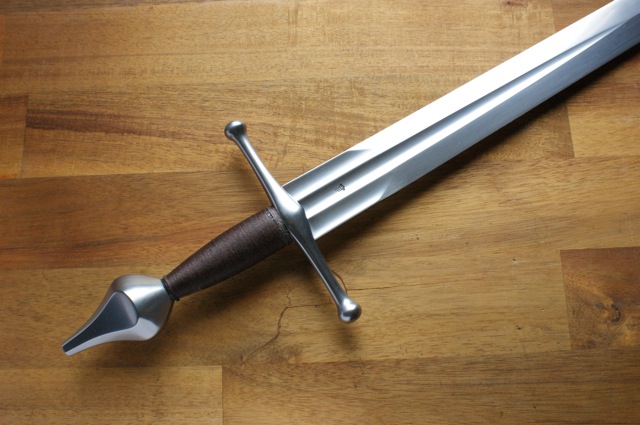
 Attachment: 81.49 KB Attachment: 81.49 KB
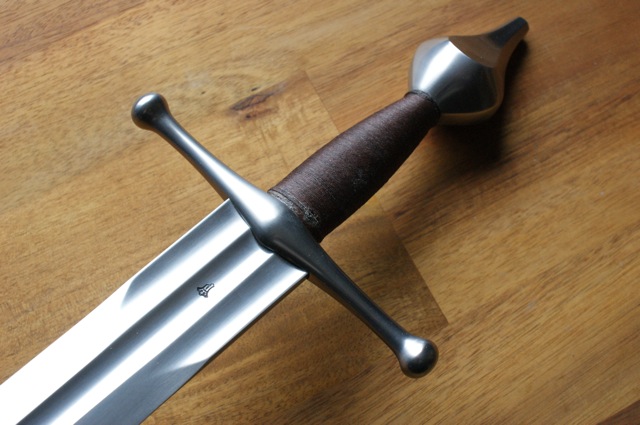
 Attachment: 76.27 KB Attachment: 76.27 KB
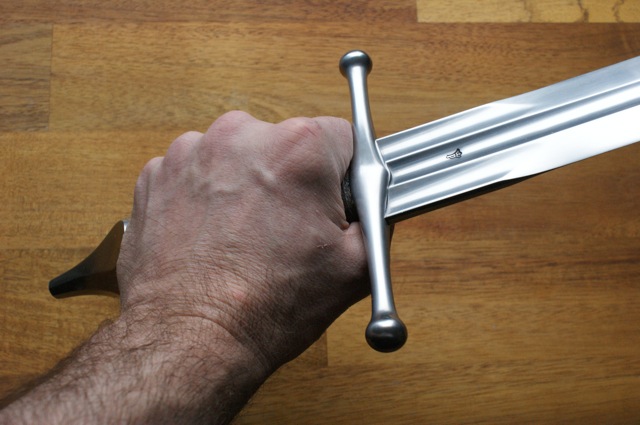
 Attachment: 68.7 KB Attachment: 68.7 KB
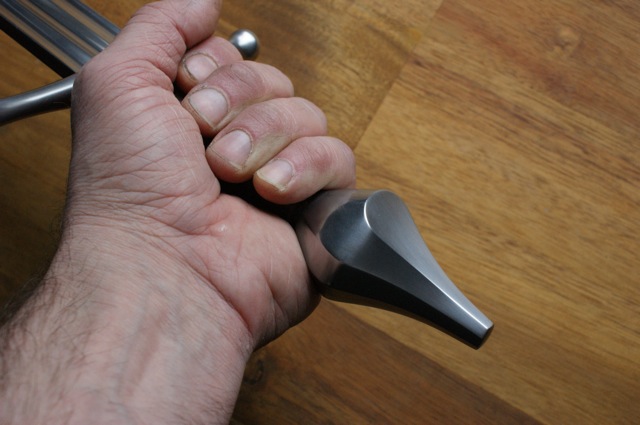
The grip is short with the pommel forming an ergonomic function. Its shape is effective in providing support for the heel of the hand.
|
|
   |
 |
|
Peter Johnsson
Industry Professional
|
 Posted: Sat 25 Feb, 2012 4:23 am Post subject: Posted: Sat 25 Feb, 2012 4:23 am Post subject: |
 |
|
Thank you guys!
-Scott: glad you find this useful. I am looking forward to see where your sword making will take you. It is exiting to see what you do.
Nat: That is high praise. Thank you.
At first glance medieval swords may look simple. But there is something subtle and even intricate in how they are shaped. Before making a reconstruction or an inspired piece, it is important to first get a good idea of the form of the originals. This idea can be defined in many different ways. I think it matters in what way you define your impressions, what aspects you mark as important. This will have a great impact on the final result.
The question is how medieval craftsmen thought about form. In what ways did they define the form of the objects they were making? What part of the shaping was conscious and what was governed by an intuitive process?
If we can get an insight into these matters it will make it possible for us to look at swords with a "higher understanding and deeper reckoning" as the 15th century gold smith Schmuttermeyer said when he described the process of design in his booklet on the correct shaping of pinnacles and gablets of reliquaries.
|
|
   |
 |
Michael Harley

|
 Posted: Sat 25 Feb, 2012 3:53 pm Post subject: Posted: Sat 25 Feb, 2012 3:53 pm Post subject: |
 |
|
|
'Sublime' is the only adjective that comes close to describing this creation.
|
|
   |
 |
Jean Thibodeau

|
 Posted: Sat 25 Feb, 2012 7:01 pm Post subject: Posted: Sat 25 Feb, 2012 7:01 pm Post subject: |
 |
|
Peter that is Jaw Dropping awesome.  
I've also noticed that with most of my better handling swords the pommel gives support to the heel of the hand ( One handed swords ) and this really makes it easier to make and control sudden stops with a sword which may mean avoiding going to far with a swing and being able to recover faster from a miss and keep one's point menacing.
As much as a well designed pommel can help you a poorly design one will get in the way and often make the gripping of the sword uncomfortable at the least.
Well, with my Albion Doge I find the same type of pommel very useful and comfortable as you describe.
You can easily give up your freedom. You have to fight hard to get it back!
|
|
  |
 |
Julien M

|
 Posted: Sun 26 Feb, 2012 5:17 am Post subject: Posted: Sun 26 Feb, 2012 5:17 am Post subject: |
 |
|
This is looking every bit as it should Peter.
I guess you must be racing to finish scabbard and grip wrap (looking forward to see which way you'll go with the grip) in time for the Arms fair so good luck and see you in London for the finish line!
J
|
|
  |
 |
|
|

